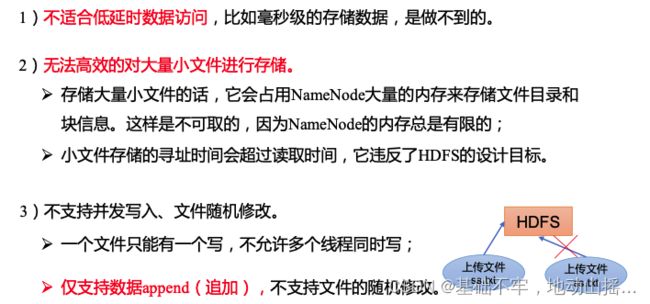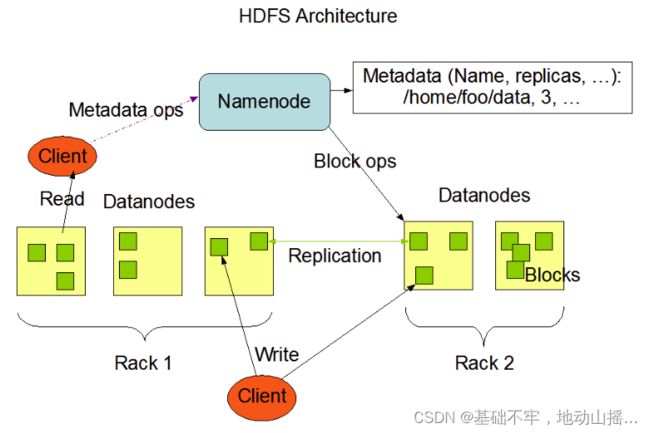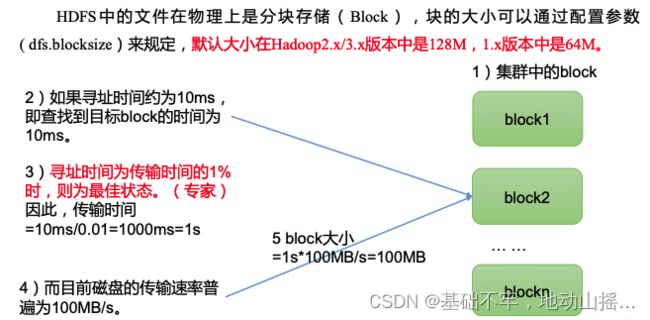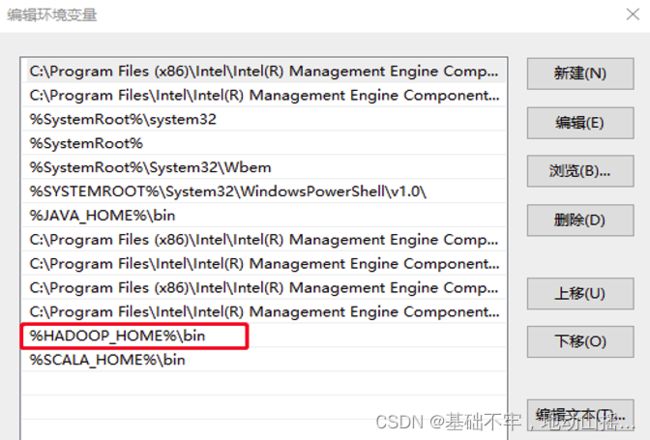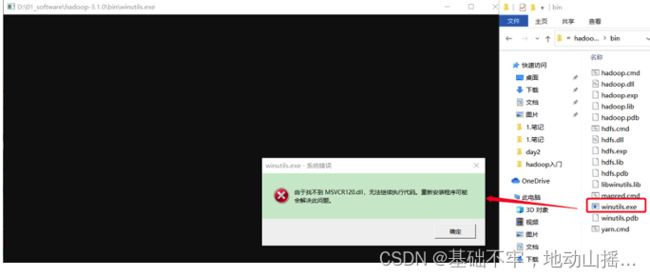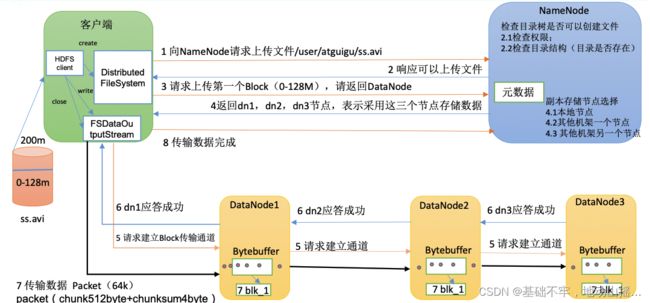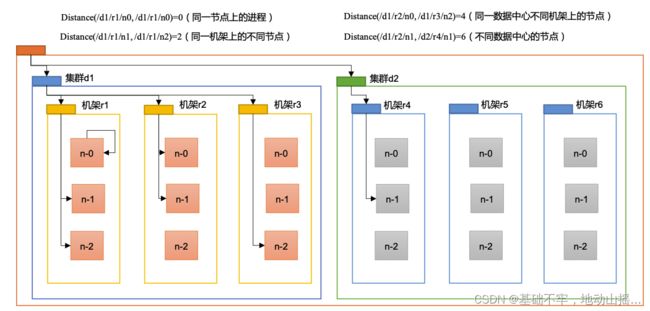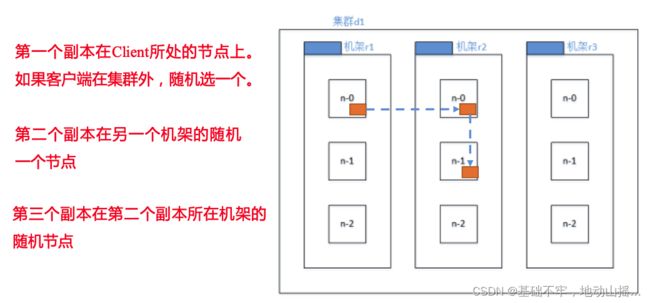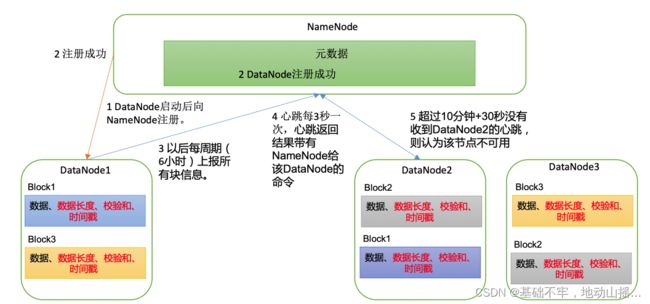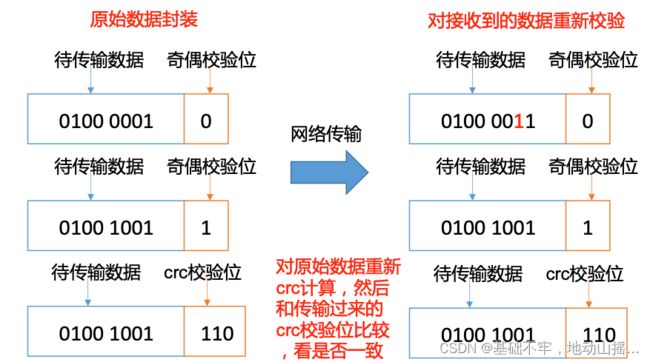Hadoop之HDFS
目录
1.HDFS概述
1.1HDFS产出背景及定义
1.2 HDFS优缺点
1.3 HDFS组成架构
1.4 HDFS文件块大小
2. HDFS的Shell操作
2.1 基本语法
2.2 命令大全
2.3 常用命令实操
2.3.1 准备工作
2.3.2 上传
2.3.3 下载
2.3.4 HDFS直接操作
3. HDFS的API操作
3.1 客户端环境准备
3.2 HDFS的API案例实操
3.2.1 HDFS文件上传(测试参数优先级)
3.2.2 HDFS文件下载
3.2.3 HDFS文件更名和移动
3.2.4 HDFS删除文件和目录
3.2.5 HDFS文件详情查看
3.2.6 HDFS文件和文件夹判断
4. HDFS的读写流程
4.1 HDFS写数据流程
4.1.1 剖析文件写入
4.1.2 网络拓扑-节点距离计算
4.1.3 机架感知(副本存储节点选择)
4.2 HDFS读数据流程
5. NameNode和SecondaryNameNode
5.1 NN和2NN工作机制
5.2 Fsimage和Edits解析
5.3 CheckPoint时间设置
6. DataNode
6.1 DataNode工作机制
6.2 数据完整性
6.3 掉线时限参数设置
1.HDFS概述
1.1HDFS产出背景及定义
HDFS产生背景
随着数据量越来越大,在一个操作系统存不下所有的数据,那么就分配到更多的操作系统管理的磁盘中,但是不方便管理和维护,迫切需要一种系统来管理多台机器上的文件,这就是分布式文件管理系统。HDFS只是分布式文件管理系统中的一种。
HDFS定义
HDFS(Hadoop Distributed File System),它是一个文件系统,用于存储文件,通过目录树来定位文件;其次,它是分布式的,由很多服务器联合起来实现其功能,集群中的服务器有各自的角色。
HDFS的使用场景:适合一次写入,多次读出的场景。一个文件经过创建、写入和关闭之后就不需要改变。
1.2 HDFS优缺点
优点
缺点
1.3 HDFS组成架构
1 ) NameNode ( nn ) : 就是Master ,它是一个主管、管理者。
- 管理HDFS的名称空间
- 配置副本策略;
- 管理数据块( Block ) 映射信息
- 处理客户端读写请求
2 ) DataNode :就是Slave。NameNode下达命令,DataNode执行实际的操作
- 存储实际的数据块;
- 执行数据块的读/写操作
3) Client: 就是客户端
- 文件切分。文件上传HDFS的时候,Client将文件切分成一个一个的Block,然后进行上传:(2)与NameNode交互,获取文件的位置信息
- 与DataNode交互,读取或者写入数据:
- Client提供一些命今来管理HDFS,比如NameNode格式化,
- Clicnt可以通过一些命今来访问HDFS,比如如对HDFS增删查改操作
4)Secondary NameNode: 并非NameNode的热备。当NameNode挂掉的时候,它并不能马上替换NameNode并提供服务
- 辅助NameNode,分担其工作量,比如定期合并Fsimage和Edits,并推送给NameNode ;
- 在紧急情况下,可辅助恢复NameNode。
1.4 HDFS文件块大小
思考 : 为什么块的大小不能设置太小,也不能设置太大 ?
- HDFS的块设置太小,会增加寻址时间,程序一直在找块的开始位置:
- 如果块设置的太大,从磁盘传输数据的时间会明显大于定位这个块开始位置所需的时间。导致程序在处理这块数据时,会非常慢
总结: HDFS块的大小设置主要取决于磁盘传输速率
2. HDFS的Shell操作
2.1 基本语法
hadoop fs 具体命令 OR hdfs dfs 具体命令两个是完全相同的。
2.2 命令大全
[xxx@hadoop102 hadoop-3.1.3]$ bin/hadoop fs
[-appendToFile ... ]
[-cat [-ignoreCrc] ...]
[-chgrp [-R] GROUP PATH...]
[-chmod [-R] PATH...]
[-chown [-R] [OWNER][:[GROUP]] PATH...]
[-copyFromLocal [-f] [-p] ... ]
[-copyToLocal [-p] [-ignoreCrc] [-crc] ... ]
[-count [-q] ...]
[-cp [-f] [-p] ... ]
[-df [-h] [ ...]]
[-du [-s] [-h] ...]
[-get [-p] [-ignoreCrc] [-crc] ... ]
[-getmerge [-nl] ]
[-help [cmd ...]]
[-ls [-d] [-h] [-R] [ ...]]
[-mkdir [-p] ...]
[-moveFromLocal ... ]
[-moveToLocal ]
[-mv ... ]
[-put [-f] [-p] ... ]
[-rm [-f] [-r|-R] [-skipTrash] ...]
[-rmdir [--ignore-fail-on-non-empty] ...]
]]
[-setrep [-R] [-w] ...]
[-stat [format] ...]
[-tail [-f] ]
[-test -[defsz] ]
[-text [-ignoreCrc] ...]
2.3 常用命令实操
2.3.1 准备工作
1)启动Hadoop集群(方便后续的测试)
[atguigu@hadoop102 hadoop-3.1.3]$ sbin/start-dfs.sh
[atguigu@hadoop103 hadoop-3.1.3]$ sbin/start-yarn.sh2) -help:输出这个命令参数
[atguigu@hadoop102 hadoop-3.1.3]$ hadoop fs -help rm3) 创建/sanguo文件夹
[atguigu@hadoop102 hadoop-3.1.3]$ hadoop fs -mkdir /sanguo2.3.2 上传
-moveFromLocal:从本地剪切粘贴到HDFS
[atguigu@hadoop102 hadoop-3.1.3]$ vim shuguo.txt
输入:
shuguo
[atguigu@hadoop102 hadoop-3.1.3]$ hadoop fs -moveFromLocal ./shuguo.txt /sanguo2)-copyFromLocal:从本地文件系统中拷贝文件到HDFS路径去
[atguigu@hadoop102 hadoop-3.1.3]$ vim weiguo.txt
输入:
weiguo
[atguigu@hadoop102 hadoop-3.1.3]$ hadoop fs -copyFromLocal weiguo.txt /sanguo3)-put:等同于copyFromLocal,生产环境更习惯用put
[atguigu@hadoop102 hadoop-3.1.3]$ vim wuguo.txt
输入:
wuguo
[atguigu@hadoop102 hadoop-3.1.3]$ hadoop fs -put ./wuguo.txt /sanguo4)-appendToFile:追加一个文件到已经存在的文件末尾
[atguigu@hadoop102 hadoop-3.1.3]$ vim liubei.txt
输入:
liubei
[atguigu@hadoop102 hadoop-3.1.3]$ hadoop fs -appendToFile liubei.txt /sanguo/shuguo.txt2.3.3 下载
1)-copyToLocal:从HDFS拷贝到本地
[atguigu@hadoop102 hadoop-3.1.3]$ hadoop fs -copyToLocal /sanguo/shuguo.txt ./2)-get:等同于copyToLocal,生产环境更习惯用get
[atguigu@hadoop102 hadoop-3.1.3]$ hadoop fs -get /sanguo/shuguo.txt ./shuguo2.txt2.3.4 HDFS直接操作
1)-ls: 显示目录信息
[atguigu@hadoop102 hadoop-3.1.3]$ hadoop fs -ls /sanguo
2)-cat:显示文件内容
[atguigu@hadoop102 hadoop-3.1.3]$ hadoop fs -cat /sanguo/shuguo.txt
3)-chgrp、-chmod、-chown:Linux文件系统中的用法一样,修改文件所属权限
[atguigu@hadoop102 hadoop-3.1.3]$ hadoop fs -chmod 666 /sanguo/shuguo.txt
[atguigu@hadoop102 hadoop-3.1.3]$ hadoop fs -chown atguigu:atguigu /sanguo/shuguo.txt
4)-mkdir:创建路径
[atguigu@hadoop102 hadoop-3.1.3]$ hadoop fs -mkdir /jinguo
5)-cp:从HDFS的一个路径拷贝到HDFS的另一个路径
[atguigu@hadoop102 hadoop-3.1.3]$ hadoop fs -cp /sanguo/shuguo.txt /jinguo
6)-mv:在HDFS目录中移动文件
[atguigu@hadoop102 hadoop-3.1.3]$ hadoop fs -mv /sanguo/wuguo.txt /jinguo
[atguigu@hadoop102 hadoop-3.1.3]$ hadoop fs -mv /sanguo/weiguo.txt /jinguo
7)-tail:显示一个文件的末尾1kb的数据
[atguigu@hadoop102 hadoop-3.1.3]$ hadoop fs -tail /jinguo/shuguo.txt
8)-rm:删除文件或文件夹
[atguigu@hadoop102 hadoop-3.1.3]$ hadoop fs -rm /sanguo/shuguo.txt
9)-rm -r:递归删除目录及目录里面内容
[atguigu@hadoop102 hadoop-3.1.3]$ hadoop fs -rm -r /sanguo
10)-du统计文件夹的大小信息
[atguigu@hadoop102 hadoop-3.1.3]$ hadoop fs -du -s -h /jinguo
27 81 /jinguo
[atguigu@hadoop102 hadoop-3.1.3]$ hadoop fs -du -h /jinguo
14 42 /jinguo/shuguo.txt
7 21 /jinguo/weiguo.txt
6 18 /jinguo/wuguo.tx说明:27表示文件大小;81表示27*3个副本;/jinguo表示查看的目录
11)-setrep:设置HDFS中文件的副本数量
[atguigu@hadoop102 hadoop-3.1.3]$ hadoop fs -setrep 10 /jinguo/shuguo.txt
![]()
这里设置的副本数只是记录在NameNode的元数据中,是否真的会有这么多副本,还得看DataNode的数量。因为目前只有3台设备,最多也就3个副本,只有节点数的增加到10台时,副本数才能达到10。
3. HDFS的API操作
3.1 客户端环境准备
1)找到资料包路径下的Windows依赖文件夹,拷贝hadoop-3.1.0到非中文路径(比如d:\)。
2)配置HADOOP_HOME环境变量
3)配置Path环境变量。
注意:如果环境变量不起作用,可以重启电脑试试。
验证Hadoop环境变量是否正常。双击winutils.exe,如果报如下错误。说明缺少微软运行库(正版系统往往有这个问题)。再资料包里面有对应的微软运行库安装包双击安装即可。
4)在IDEA中创建一个Maven工程HdfsClientDemo,并导入相应的依赖坐标+日志添加
org.apache.hadoop
hadoop-client
3.1.3
junit
junit
4.12
org.slf4j
slf4j-log4j12
1.7.30
在项目的src/main/resources目录下,新建一个文件,命名为“log4j.properties”,在文件中填入
log4j.rootLogger=INFO, stdout
log4j.appender.stdout=org.apache.log4j.ConsoleAppender
log4j.appender.stdout.layout=org.apache.log4j.PatternLayout
log4j.appender.stdout.layout.ConversionPattern=%d %p [%c] - %m%n
log4j.appender.logfile=org.apache.log4j.FileAppender
log4j.appender.logfile.File=target/spring.log
log4j.appender.logfile.layout=org.apache.log4j.PatternLayout
log4j.appender.logfile.layout.ConversionPattern=%d %p [%c] - %m%n5)创建包名:com.atguigu.hdfs
6)创建HdfsClient类
public class HdfsClient {
@Test
public void testMkdirs() throws IOException, URISyntaxException, InterruptedException {
// 1 获取文件系统
Configuration configuration = new Configuration();
// FileSystem fs = FileSystem.get(new URI("hdfs://hadoop102:8020"), configuration);
FileSystem fs = FileSystem.get(new URI("hdfs://hadoop102:8020"), configuration,"atguigu");
// 2 创建目录
fs.mkdirs(new Path("/xiyou/huaguoshan/"));
// 3 关闭资源
fs.close();
}
}7)执行程序
客户端去操作HDFS时,是有一个用户身份的。默认情况下,HDFS客户端API会从采用Windows默认用户访问HDFS,会报权限异常错误。所以在访问HDFS时,一定要配置用户。
org.apache.hadoop.security.AccessControlException: Permission denied: user=56576, access=WRITE, inode="/xiyou/huaguoshan":atguigu:supergroup:drwxr-xr-x
3.2 HDFS的API案例实操
3.2.1 HDFS文件上传(测试参数优先级)
1)编写源代码
@Test
public void testCopyFromLocalFile() throws IOException, InterruptedException, URISyntaxException {
// 1 获取文件系统
Configuration configuration = new Configuration();
configuration.set("dfs.replication", "2");
FileSystem fs = FileSystem.get(new URI("hdfs://hadoop102:8020"), configuration, "atguigu");
// 2 上传文件
fs.copyFromLocalFile(new Path("d:/sunwukong.txt"), new Path("/xiyou/huaguoshan"));
// 3 关闭资源
fs.close();
}2)将hdfs-site.xml拷贝到项目的resources资源目录下(该操作用对于hdfs进行设置,如配置副本数量等)
dfs.replication
1
3) 参数优先级
参数优先级排序:(1)客户端代码中设置的值 >(2)ClassPath下的用户自定义配置文件 >(3)然后是服务器的自定义配置(xxx-site.xml) >(4)服务器的默认配置(xxx-default.xml)
3.2.2 HDFS文件下载
@Test
public void testCopyToLocalFile() throws IOException, InterruptedException, URISyntaxException{
// 1 获取文件系统
Configuration configuration = new Configuration();
FileSystem fs = FileSystem.get(new URI("hdfs://hadoop102:8020"), configuration, "atguigu");
// 2 执行下载操作
// boolean delSrc 指是否将原文件删除
// Path src 指要下载的文件路径
// Path dst 指将文件下载到的路径
// boolean useRawLocalFileSystem 是否开启文件校验
fs.copyToLocalFile(false, new Path("/xiyou/huaguoshan/sunwukong.txt"), new Path("d:/sunwukong2.txt"), true);
// 3 关闭资源
fs.close();
}3.2.3 HDFS文件更名和移动
@Test
public void testRename() throws IOException, InterruptedException, URISyntaxException{
// 1 获取文件系统
Configuration configuration = new Configuration();
FileSystem fs = FileSystem.get(new URI("hdfs://hadoop102:8020"), configuration, "atguigu");
// 2 修改文件名称
fs.rename(new Path("/xiyou/huaguoshan/sunwukong.txt"), new Path("/xiyou/huaguoshan/meihouwang.txt"));
// 3 关闭资源
fs.close();
}3.2.4 HDFS删除文件和目录
@Test
public void testDelete() throws IOException, InterruptedException, URISyntaxException{
// 1 获取文件系统
Configuration configuration = new Configuration();
FileSystem fs = FileSystem.get(new URI("hdfs://hadoop102:8020"), configuration, "atguigu");
// 2 执行删除
fs.delete(new Path("/xiyou"), true);
// 3 关闭资源
fs.close();
}3.2.5 HDFS文件详情查看
查看文件名称、权限、长度、块信息
@Test
public void testListFiles() throws IOException, InterruptedException, URISyntaxException {
// 1获取文件系统
Configuration configuration = new Configuration();
FileSystem fs = FileSystem.get(new URI("hdfs://hadoop102:8020"), configuration, "atguigu");
// 2 获取文件详情
RemoteIterator listFiles = fs.listFiles(new Path("/"), true);
while (listFiles.hasNext()) {
LocatedFileStatus fileStatus = listFiles.next();
System.out.println("========" + fileStatus.getPath() + "=========");
System.out.println(fileStatus.getPermission());
System.out.println(fileStatus.getOwner());
System.out.println(fileStatus.getGroup());
System.out.println(fileStatus.getLen());
System.out.println(fileStatus.getModificationTime());
System.out.println(fileStatus.getReplication());
System.out.println(fileStatus.getBlockSize());
System.out.println(fileStatus.getPath().getName());
// 获取块信息
BlockLocation[] blockLocations = fileStatus.getBlockLocations();
System.out.println(Arrays.toString(blockLocations));
}
// 3 关闭资源
fs.close();
}
3.2.6 HDFS文件和文件夹判断
@Test
public void testListStatus() throws IOException, InterruptedException, URISyntaxException{
// 1 获取文件配置信息
Configuration configuration = new Configuration();
FileSystem fs = FileSystem.get(new URI("hdfs://hadoop102:8020"), configuration, "atguigu");
// 2 判断是文件还是文件夹
FileStatus[] listStatus = fs.listStatus(new Path("/"));
for (FileStatus fileStatus : listStatus) {
// 如果是文件
if (fileStatus.isFile()) {
System.out.println("f:"+fileStatus.getPath().getName());
}else {
System.out.println("d:"+fileStatus.getPath().getName());
}
}
// 3 关闭资源
fs.close();
}4. HDFS的读写流程
4.1 HDFS写数据流程
4.1.1 剖析文件写入
(1)客户端通过Distributed FileSystem模块向NameNode请求上传文件,NameNode检查目标文件是否已存在,父目录是否存在。
(2)NameNode返回是否可以上传。
(3)客户端请求第一个 Block上传到哪几个DataNode服务器上。
(4)NameNode返回3个DataNode节点,分别为dn1、dn2、dn3。
(5)客户端通过FSDataOutputStream模块请求dn1上传数据,dn1收到请求会继续调用dn2,然后dn2调用dn3,将这个通信管道建立完成。
(6)dn1、dn2、dn3逐级应答客户端。
(7)客户端开始往dn1上传第一个Block(先从磁盘读取数据放到一个本地内存缓存),以Packet为单位,dn1收到一个Packet就会传给dn2,dn2传给dn3;dn1每传一个packet会放入一个应答队列等待应答。
(8)当一个Block传输完成之后,客户端再次请求NameNode上传第二个Block的服务器。(重复执行3-7步)。
4.1.2 网络拓扑-节点距离计算
在HDFS写数据的过程中,NameNode会选择距离待上传数据最近距离的DataNode接收数据。那么这个最近距离怎么计算呢?
节点距离:两个节点到达最近的共同祖先的距离总和。
例如,假设有数据中心d1机架r1中的节点n1。该节点可以表示为/d1/r1/n1。利用这种标记,这里给出四种距离描述。
4.1.3 机架感知(副本存储节点选择)
机架感知说明
(1)官方说明
https://hadoop.apache.org/docs/r3.1.3/hadoop-project-dist/hadoop-hdfs/HdfsDesign.html#Data_Replication
For the common case, when the replication factor is three, HDFS’s placement policy is to put one replica on the local machine if the writer is on a datanode, otherwise on a random datanode, another replica on a node in a different (remote) rack, and the last on a different node in the same remote rack. This policy cuts the inter-rack write traffic which generally improves write performance. The chance of rack failure is far less than that of node failure; this policy does not impact data reliability and availability guarantees. However, it does reduce the aggregate network bandwidth used when reading data since a block is placed in only two unique racks rather than three. With this policy, the replicas of a file do not evenly distribute across the racks. One third of replicas are on one node, two thirds of replicas are on one rack, and the other third are evenly distributed across the remaining racks. This policy improves write performance without compromising data reliability or read performance.
(2)源码说明
Crtl + n 查找BlockPlacementPolicyDefault,在该类中查找chooseTargetInOrder方法。
Hadoop3.1.3副本节点选择
4.2 HDFS读数据流程
(1)客户端通过DistributedFileSystem向NameNode请求下载文件,NameNode通过查询元数据,找到文件块所在的DataNode地址。
(2)挑选一台DataNode(就近原则,然后随机)服务器,请求读取数据。
(3)DataNode开始传输数据给客户端(从磁盘里面读取数据输入流,以Packet为单位来做校验)。
(4)客户端以Packet为单位接收,先在本地缓存,然后写入目标文件。
5. NameNode和SecondaryNameNode
5.1 NN和2NN工作机制
思考:NameNode中的元数据是存储在哪里的?
首先,我们做个假设,如果存储在NameNode节点的磁盘中,因为经常需要进行随机访问,还有响应客户请求,必然是效率过低。因此,元数据需要存放在内存中。但如果只存在内存中,一旦断电,元数据丢失,整个集群就无法工作了。因此产生在磁盘中备份元数据的FsImage。
这样又会带来新的问题,当在内存中的元数据更新时,如果同时更新FsImage,就会导致效率过低,但如果不更新,就会发生一致性问题,一旦NameNode节点断电,就会产生数据丢失。因此,引入Edits文件(只进行追加操作,效率很高)。每当元数据有更新或者添加元数据时,修改内存中的元数据并追加到Edits中。这样,一旦NameNode节点断电,可以通过FsImage和Edits的合并,合成元数据。
但是,如果长时间添加数据到Edits中,会导致该文件数据过大,效率降低,而且一旦断电,恢复元数据需要的时间过长。因此,需要定期进行FsImage和Edits的合并,如果这个操作由NameNode节点完成,又会效率过低。因此,引入一个新的节点SecondaryNamenode,专门用于FsImage和Edits的合并。
NameNode工作机制
1)第一阶段:NameNode启动
(1)第一次启动NameNode格式化后,创建Fsimage和Edits文件。如果不是第一次启动,直接加载编辑日志和镜像文件到内存。
(2)客户端对元数据进行增删改的请求。
(3)NameNode记录操作日志,更新滚动日志。
(4)NameNode在内存中对元数据进行增删改。
2)第二阶段:Secondary NameNode工作
(1)Secondary NameNode询问NameNode是否需要CheckPoint。直接带回NameNode是否检查结果。
(2)Secondary NameNode请求执行CheckPoint。
(3)NameNode滚动正在写的Edits日志。
(4)将滚动前的编辑日志和镜像文件拷贝到Secondary NameNode。
(5)Secondary NameNode加载编辑日志和镜像文件到内存,并合并。
(6)生成新的镜像文件fsimage.chkpoint。
(7)拷贝fsimage.chkpoint到NameNode。
(8)NameNode将fsimage.chkpoint重新命名成fsimage。
5.2 Fsimage和Edits解析
NameNode被格式化之后,将在/opt/module/hadoop-3.1.3/data/tmp/dfs/name/current目录中产生如下文件
fsimage_0000000000000000000
fsimage_0000000000000000000.md5
seen_txid
VERSION(1)Fsimage文件:HDFS文件系统元数据的一个永久性的检查点,其中包含HDFS文件系统的所有目 录和文件inode的序列化信息。
(2)Edits文件:存放HDFS文件系统的所有更新操作的路径,文件系统客户端执行的所有写操作首先 会被记录到Edits文件中。
(3)seen_txid文件保存的是一个数字,就是最后一个edits_的数字
(4)每次NameNode启动的时候都会将Fsimage文件读入内存,加载Edits里面的更新操作,保证内存中的元数据信息是最新的、同步的,可以看成NameNode启动的时候就将Fsimage和Edits文件进行了合并。
1) oiv查看Fsimage文件
(1)查看oiv和oev命令
[atguigu@hadoop102 current]$ hdfs
oiv apply the offline fsimage viewer to an fsimage
oev apply the offline edits viewer to an edits file(2)基本语法
hdfs oiv -p 文件类型 -i镜像文件 -o 转换后文件输出路径
(3)案例实操
[atguigu@hadoop102 current]$ pwd
/opt/module/hadoop-3.1.3/data/dfs/name/current
[atguigu@hadoop102 current]$ hdfs oiv -p XML -i
fsimage_0000000000000000025 -o /opt/module/hadoop-3.1.3/fsimage.xml
[atguigu@hadoop102 current]$ cat /opt/module/hadoop-3.1.3/fsimage.xml将显示的xml文件内容拷贝到Idea中创建的xml文件中,并格式化。部分显示结果如下。
16386
DIRECTORY
user
1512722284477
atguigu:supergroup:rwxr-xr-x
-1
-1
16387
DIRECTORY
atguigu
1512790549080
atguigu:supergroup:rwxr-xr-x
-1
-1
16389
FILE
wc.input
3
1512722322219
1512722321610
134217728
atguigu:supergroup:rw-r--r--
1073741825
1001
59
思考:可以看出,Fsimage中没有记录块所对应DataNode,为什么?
在集群启动后,要求DataNode上报数据块信息,并间隔一段时间后再次上报。
2)oev查看Edits文件
(1)基本语法
hdfs oev -p 文件类型 -i编辑日志 -o 转换后文件输出路径(2)案例实操
[atguigu@hadoop102 current]$ hdfs oev -p XML -i
edits_0000000000000000012-0000000000000000013 -o /opt/module/hadoop-3.1.3/edits.xml
[atguigu@hadoop102 current]$ cat /opt/module/hadoop-3.1.3/edits.xml将显示的xml文件内容拷贝到Idea中创建的xml文件中,并格式化。显示结果如下。
-63
OP_START_LOG_SEGMENT
129
OP_ADD
130
0
16407
/hello7.txt
2
1512943607866
1512943607866
134217728
DFSClient_NONMAPREDUCE_-1544295051_1
192.168.10.102
true
atguigu
supergroup
420
908eafd4-9aec-4288-96f1-e8011d181561
0
OP_ALLOCATE_BLOCK_ID
131
1073741839
OP_SET_GENSTAMP_V2
132
1016
OP_ADD_BLOCK
133
/hello7.txt
1073741839
0
1016
-2
OP_CLOSE
134
0
0
/hello7.txt
2
1512943608761
1512943607866
134217728
false
1073741839
25
1016
atguigu
supergroup
420
5.3 CheckPoint时间设置
1)通常情况下,SecondaryNameNode每隔一小时执行一次。
[hdfs-default.xml]
dfs.namenode.checkpoint.period
3600s
2)一分钟检查一次操作次数,当操作次数达到1百万时,SecondaryNameNode执行一次。
dfs.namenode.checkpoint.txns
1000000
操作动作次数
dfs.namenode.checkpoint.check.period
60s
1分钟检查一次操作次数
6. DataNode
6.1 DataNode工作机制
(1)一个数据块在DataNode上以文件形式存储在磁盘上,包括两个文件,一个是数据本身,一个是元数据包括数据块的长度,块数据的校验和,以及时间戳。
(2)DataNode启动后向NameNode注册,通过后,周期性(6小时)的向NameNode上报所有的块信息。
DN向NN汇报当前解读信息的时间间隔,默认6小时;
dfs.blockreport.intervalMsec
21600000
Determines block reporting interval in milliseconds.
DN扫描自己节点块信息列表的时间,默认6小时
dfs.datanode.directoryscan.interval
21600s
Interval in seconds for Datanode to scan data directories and reconcile the difference between blocks in memory and on the disk.
Support multiple time unit suffix(case insensitive), as described
in dfs.heartbeat.interval.
(3)心跳是每3秒一次,心跳返回结果带有NameNode给该DataNode的命令如复制块数据到另一台机器,或删除某个数据块。如果超过10分钟没有收到某个DataNode的心跳,则认为该节点不可用。
(4)集群运行中可以安全加入和退出一些机器。
6.2 数据完整性
思考:如果电脑磁盘里面存储的数据是控制高铁信号灯的红灯信号(1)和绿灯信号(0),但是存储该数据的磁盘坏了,一直显示是绿灯,是否很危险?同理DataNode节点上的数据损坏了,却没有发现,是否也很危险,那么如何解决呢?
如下是DataNode节点保证数据完整性的方法。
(1)当DataNode读取Block的时候,它会计算CheckSum。
(2)如果计算后的CheckSum,与Block创建时值不一样,说明Block已经损坏。
(3)Client读取其他DataNode上的Block。
(4)常见的校验算法crc(32),md5(128),sha1(160)
(5)DataNode在其文件创建后周期验证CheckSum。
6.3 掉线时限参数设置
需要注意的是hdfs-site.xml 配置文件中的heartbeat.recheck.interval的单位为毫秒,dfs.heartbeat.interval的单位为秒。
dfs.namenode.heartbeat.recheck-interval
300000
dfs.heartbeat.interval
3
参考资料:尚硅谷大数据Hadoop教程,hadoop3.x搭建到集群调优,百万播放_哔哩哔哩_bilibili

